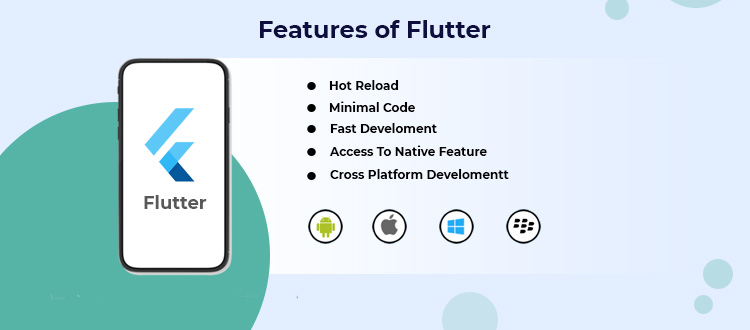Why Choose Flutter for Cross Platform Mobile App Development ?
There are several reasons why developers choose Flutter for cross-platform mobile app development:
- Fast Development: Flutter has a “Hot Reload” feature which allows for faster development and easier bug fixing.
- Single Codebase: Flutter allows for a single codebase for both Android and iOS platforms, making the development process faster and more cost-effective.
- Customizable and Beautiful UI: Flutter provides a rich set of customizable widgets and tools for building beautiful and unique user interfaces.
- Native Performance: Flutter apps have smooth and fast performance that is comparable to natively developed apps.
- Large Community: Flutter has a large and growing community of developers, which means that there is a wealth of resources and support available.
- Dart Language: Flutter uses Dart as its primary programming language, which is easy to learn and use for developers who are already familiar with object-oriented programming.
What’s Flutter?
Flutter is a free, open-source mobile application development framework created by Google. It is used to develop native-looking, high-performance applications for iOS and Android platforms with a single codebase. It uses the Dart programming language and provides a rich set of customizable widgets and tools for building beautiful and unique user interfaces. With its fast development cycle, native performance, and large community of developers, Flutter is a popular choice for cross-platform mobile app development.
Is Flutter better than Xamarin or React Native?
Comparing Flutter, Xamarin, and React Native is like comparing apples to oranges, as each framework has its own strengths and weaknesses and is better suited to certain types of projects.
Flutter is known for its fast development cycle and beautiful, customizable UI. It provides native-like performance and has a large, growing community of developers.
Xamarin, on the other hand, is a Microsoft product that uses C# and has a long history of supporting both Android and iOS platforms. It offers access to the full range of native APIs and has a large community of developers, especially in the enterprise space.
React Native is a JavaScript framework for building native apps using Facebook’s React library. It has a large community of developers and a large library of reusable components. It allows for faster development and can be used to build high-performance apps, but the UI may not be as smooth as with Flutter or Xamarin.
Reasons to Consider Cross Platform App Development Over Native Development
There are several reasons why developers may choose to go with cross-platform app development over native development:
- Cost-Effective: Cross-platform development allows for the creation of a single codebase that can be used for multiple platforms, reducing development costs compared to native development for each platform.
- Faster Time to Market: Cross-platform development can help speed up the development process, allowing for faster time to market.
- Large Pool of Developers: Cross-platform development has a large pool of developers, making it easier to find the talent needed for a project.
- Easier Maintenance: With a single codebase, it’s easier to maintain and update the app in the future.
- Reach a Wider Audience: Cross-platform development allows for the creation of apps that can run on multiple platforms, reaching a wider audience.
- Better User Experience: Cross-platform development frameworks, such as Flutter, provide a consistent look and feel across platforms, resulting in a better user experience.
What Are The Features of Flutter?

Flutter has a range of features that make it a popular choice for cross-platform mobile app development. Some of the key features of Flutter include:
- Fast Development: Flutter has a “Hot Reload” feature which allows for faster development and easier bug fixing.
- Single Codebase: Flutter allows for a single codebase for both Android and iOS platforms, making the development process faster and more cost-effective.
- Customizable and Beautiful UI: Flutter provides a rich set of customizable widgets and tools for building beautiful and unique user interfaces.
- Native Performance: Flutter apps have smooth and fast performance that is comparable to natively developed apps.
- Large Community: Flutter has a large and growing community of developers, which means that there is a wealth of resources and support available.
- Dart Language: Flutter uses Dart as its primary programming language, which is easy to learn and use for developers who are already familiar with object-oriented programming.
- Hot Reload: Flutter’s hot reload feature allows developers to see the changes they make to the code in real-time, speeding up the development process.
- Access to Native Features: Flutter provides access to native features and APIs on both Android and iOS platforms.
- Reactive Programming: Flutter uses reactive programming, which allows for a more efficient and responsive app.
- Animations and Graphics: Flutter provides an easy way to create animations and graphics, making it possible to build engaging and interactive apps.
Top Apps Built with Flutter
Flutter has been used to build many high-quality and popular mobile apps, here are a few examples:
- Alibaba: A global retail and technology company that has used Flutter to develop its Xianyu app for iOS and Android.
- Google Ads: Google’s mobile app for managing AdWords campaigns, built with Flutter.
- Hamilton Musical: The official app for the hit Broadway musical, Hamilton, built with Flutter.
- Reflectly: A personal journal app that uses Flutter for its beautiful and customizable user interface.
- Birch Finance: A personal finance app that helps users manage their credit cards, built with Flutter.
- Coach Yourself: A self-coaching app that uses Flutter for its fast and responsive user interface.
- Tencent Video: A popular video streaming app in China, built with Flutter.
- Xianyu: Alibaba’s second-hand goods buying and selling platform, also built with Flutter.
Conclusion
In conclusion, Flutter is a powerful cross-platform mobile app development framework that has gained a lot of popularity among developers in recent years. With features such as fast development, a single codebase, beautiful and customizable UI, and native-like performance, it provides a solution for building high-quality, engaging, and interactive mobile apps that can run on both Android and iOS platforms. Additionally, the large and growing community of developers provides a wealth of resources and support, making it easier for developers to get started and build great apps. With these benefits, it’s not surprising that many top apps have been built with Flutter, and it continues to be a popular choice for mobile app development.
Know More:
Mobile App Development Company in India
Mobile app development company in India
Mobile app development company in USA



ReplyDeletePost Free Ads, Website Directory, Directory Submission
Free Listing, Free Web Directory Submission, Free High DA Directory
Free classified ad posting, Free Link Directory
Free blog posts, Ad Posting
Local news, Breaking News, Technology News
Nice blog
ReplyDeleteI am really impressed by reading this blog.
Admylisting.com, Classifieds in India
Blog Commenting
Nice blog
ReplyDeleteI am really impressed by reading this blog.
Add Free Listing.
Admylisting.com, Classifieds in India
Blog Commenting